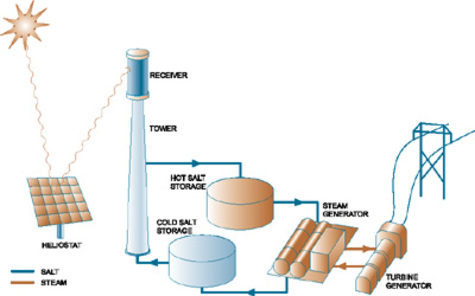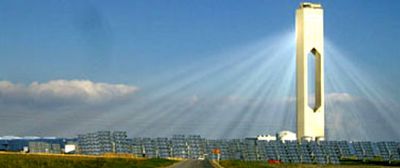|
Solar Power Tower
World's first commercial solar power tower located in Andalusia, Spain.The solar power towers I'll describe on this page use sunlight reflected from a series of mirrors to a central device called a receiver. The receiver collects the energy as heat which then turns turbines to generate electricity. (There are other proven designs I'll discuss elsewhere.) In practice, the receiver is mounted on a tall tower in the center of a large field. Mirrors, numbering in the hundreds or even thousands, fill the field and reflect sunlight to the receiver. These mirrors are called heliostats. They track the sun throughout the day to keep energy focused on the receiver. This is not something you can do at home. These systems need to be large to be practical. As you’ll see the engineering demands are complex. Early designs used water changed to steam by the suns energy to drive turbines. This worked, but more sophisticated and effective designs have been developed. Newer systems use liquid salt because of its thermal characteristics. The salt is usually a mixture of 60% sodium nitrate and 40% potassium nitrate. The mixture melts at 220C/428F. In use, “cold” (about 500F) salt is pumped from a holding tank through the reciever where the focused sun light heats it to over 1000F (!). The salt then passes back down the tower into a well-insulated “hot” tank. When its time to make power, the hot salt passes through a heat exchanger that makes steam to drive turbines. The melted salt loses heat in the process and returns to the cold tank. The cycle can be repeated when the sun shines again. 
A major advantage of using liquid salt in a solar power tower is its ability to hold heat. The salt melts at a high temperature and stays in liquid form at temperatures that would vaporize other materials. When the power plant stores the hot salt in a well-insulated tank, it is storing the heat collected from the sun for use at another time. This reservoir of salt allows energy production to continue even after the sun goes down. An important part of the design of tower system is to have the optimal number of heliostats and appropriately sized storage systems to hold the energy. Ideally, during daylight there is enough heat to run the turbines at full capacity and also build up a reservoir of hot salt in the storage tank As you might imagine, salt at this high a temperature can be quite corrosive and difficult to handle well. However engineers have been able to meet the challenges involves and tower systems are practical. By the way, the melted salt has about the same viscosity as water. The system is closed and there is no exhaust to the atmosphere. If a leak should develop, the salt would “freeze” (return to solid form) almost instantly so there is essentially no chance of significant contamination. Although the engineering is complex, solar power towers produce a very clean and safe form of electricity. Links to Other Solar Energy PagesClick here to go to Solar Energy Click here to go to Solar Panels Click here to go to Passive Solar Home Design Click here to go to Solar Hot Water Other LinksClick here to go to Alternative Energy Primer Home from Solar Power Tower |
